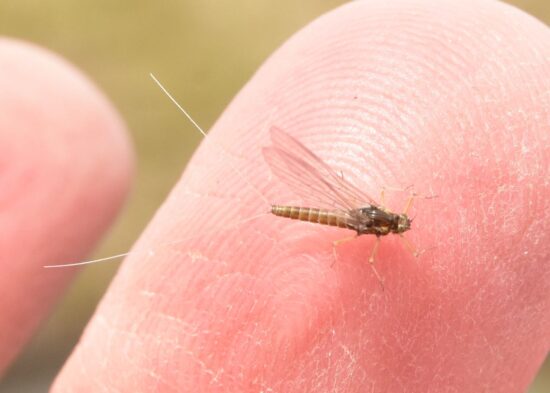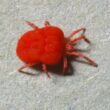Mayflies can turn a peaceful evening outdoors into a real nightmare. These aquatic insects might only live for a day or two as adults, but when they swarm by the thousands around your home, they create quite a mess. While mayflies don’t bite or sting, their massive numbers can make outdoor activities nearly impossible and leave slippery piles of dead insects everywhere.
The good news? Learning how to get rid of mayflies doesn’t have to be complicated. These delicate insects are actually pretty easy to manage once you understand what attracts them and how to disrupt their lifecycle. Mayflies spend most of their lives underwater as nymphs, then emerge all at once during warmer months to mate and die.
Before you start getting rid of mayflies, it’s worth knowing that their presence actually indicates a healthy water ecosystem. They can’t survive in polluted water, so seeing them means your local environment is in good shape. Still, when they cover your patio furniture and make driving dangerous, it’s time to take action.
This article goes over effective methods for mayfly control, from simple lighting changes to more intensive treatments. The best approach combines several of these techniques to target both the adult flies and their breeding areas.
1. Turn Off or Replace Your Outdoor Lights
The easiest way to start getting rid of mayflies is to address what attracts them most: bright lights. Mayflies are drawn to white and bright lights like moths to a flame, and they’ll swarm around porch lights, streetlights, and illuminated signs in massive numbers.
During mayfly season (typically May through August), turn off any unnecessary outdoor lighting. For lights you need to keep on for safety, swap out white incandescent and fluorescent bulbs for yellow “bug light” bulbs. These special bulbs produce light that’s much less attractive to flying insects.
If you have mercury vapor lamps, replace them with high pressure sodium vapor lights. LED lights work well too, but stick with warm color temperatures of 3000K or lower. The higher the number, the more blue light the bulb produces, and mayflies love blue light.
You can also move lights away from doorways and windows when possible. Use curtains, blinds, or shades to keep indoor light from shining outside during peak mayfly hours in the evening.
This method works because mayflies navigate using natural light sources like the moon and stars. Artificial lights confuse their navigation system and draw them in huge numbers to your property.
2. Sweep and Spray Them Away
Sometimes the simplest solutions work best. Since mayflies are extremely delicate, you can easily remove them with basic tools you already have at home.
Use a regular broom and dustpan to gently sweep mayflies off your porch, patio furniture, and outdoor surfaces. A standard garden hose works great for spraying them off walls, windows, and larger areas. For bigger jobs, a pressure washer can clear mayflies from entire building sides quickly.
If mayflies get inside your house, a handheld vacuum with a HEPA filter makes quick work of them. Just vacuum them up and dispose of the bag or empty the canister outside.
The key is to clean up regularly during peak emergence periods. Mayflies that die naturally will pile up and create slippery, smelly messes that are much harder to clean later.
This approach works because mayflies are so fragile that gentle sweeping or water pressure easily dislodges them. Plus, regular cleanup prevents the buildup of dead insects that can cause allergic reactions in sensitive people.
3. Remove Standing Water Around Your Property
Since mayfly nymphs develop in still water, eliminating these breeding sites is crucial for long term control. Walk around your property and look for any containers or areas that collect and hold water.
Empty birdbaths, plant saucers, buckets, and any other containers that collect rainwater. Store items like wheelbarrows and planters upside down when not in use. Clean out gutters and downspouts regularly to prevent water from pooling.
Fix any drainage problems in your yard by filling low spots where water tends to collect. If you have areas that consistently flood, consider installing French drains or other drainage solutions.
Keep swimming pools covered when not in use. While mayflies don’t breed in chlorinated pools, they might still be attracted to the water surface.
This method targets the root of the problem. How to get rid of mayflies permanently starts with eliminating the places where they can reproduce. Without suitable breeding sites, mayfly populations around your property will naturally decrease over time.
4. Improve Water Movement in Ponds and Water Features
If you have decorative ponds, water features, or live near natural water bodies, you can make these areas less suitable for mayfly reproduction without eliminating them entirely.
Install aerators, fountains, or small pumps to keep water moving. Mayfly nymphs prefer still, oxygen poor water with lots of organic matter. Moving water discourages egg laying and makes the environment less suitable for nymph development.
Add floating plants like water lilies to your pond. These plants remove excess nutrients from the water and help prevent the algae growth that mayfly nymphs feed on. Regularly clean out fallen leaves, plant debris, and sediment from water features.
Consider stocking ponds with fish that eat mayfly nymphs, such as bluegill, bass, or trout. These fish provide natural population control and add another level of biological balance to your water feature.
This approach works because it makes existing water sources less attractive for mayfly reproduction while maintaining the aesthetic and environmental benefits of water features.
5. Set Up Sticky Traps
- Pre-scented sticky traps for spiders, roaches, crickets & more
- Long-lasting, pet-safe, non-toxic formula with no odor
- Foldable design protects glue from dust and keeps traps hidden
- Made in the USA for year-round indoor pest control
Sticky traps provide an environmentally friendly way to catch flying mayflies without using chemicals. These traps work especially well during peak emergence periods when mayflies are most active.
Hang yellow sticky traps near outdoor lights, around water features, and in areas where you’ve noticed high mayfly activity. The bright yellow color attracts flying insects, and the sticky surface traps them when they land.
Place traps about 3 to 4 feet off the ground for best results. You’ll need to replace them regularly, especially after rain washes off the sticky coating or when they become covered with insects.
Use sticky traps alongside other control methods rather than relying on them alone. They work best for monitoring mayfly activity and providing some population reduction, but won’t solve a major infestation by themselves.
These traps are effective because they take advantage of mayflies’ attraction to bright colors and provide a non toxic way to remove flying adults from your outdoor spaces.
6. Apply Professional Grade Insecticide Barriers
For serious mayfly problems, a professional insecticide treatment can provide longer lasting control. Products containing bifenthrin, like Supreme IT, create a protective barrier around your property that kills or repels mayflies for up to 90 days.
Apply the insecticide around your home’s foundation, on lawn areas, and to shrubs and ornamental plants. Pay special attention to door frames, window frames, and areas around outdoor lights where mayflies tend to gather.
Mix the product according to label directions (typically 1 fluid ounce per gallon of water for every 1,000 square feet). Use a pump sprayer to apply the solution evenly, and don’t let people or pets into treated areas until the spray has dried completely.
Time your applications for early April, before peak mayfly emergence begins. This creates a protective barrier that’s already in place when the insects start appearing.
This method provides reliable, long lasting control because it creates a chemical barrier that kills mayflies when they come into contact with treated surfaces. The residual effect means you don’t have to reapply constantly during peak season.
7. Use Chemical Foggers for Severe Swarms
When mayfly swarms become overwhelming, chemical foggers can provide rapid knockdown of large numbers of flying insects. These devices create a fine mist of insecticide that penetrates areas where mayflies hide and rest.
Use pyrethrin based fogging solutions like CSI 4-4 or Summit Mistocide with either thermal or ULV (ultra low volume) foggers. Apply treatments during early morning or late afternoon when mayflies are most active and wind conditions are calm.
Focus fogging efforts on outdoor areas where mayflies congregate, such as around lights, near water sources, and in landscaped areas with dense vegetation. The fine mist reaches places that regular spraying might miss.
Consider hiring a professional pest control company for fogging treatments, especially if you’re dealing with massive swarms. They have the proper equipment and experience to apply foggers safely and effectively.
Foggers work by delivering insecticide directly to flying insects and creating a temporary zone of protection. The fine droplets stay suspended in air long enough to contact mayflies that fly through the treated area.
8. Install Bug Zappers Strategically
- 4200V electric grid zaps mosquitoes, flies, moths, and gnats fast
- Covers up to ½ acre—great for patios, gardens, and camping
- Chemical-free pest control, safe around pets and kids
- Easy setup with hanging loop, removable tray, and replaceable bulb
Electric bug zappers can help reduce mayfly numbers, but proper placement is key to making them effective without creating new problems.
Position bug zappers away from outdoor seating areas and doorways. You want to draw mayflies away from places where people gather, not attract them closer. Place zappers at least 15 to 20 feet from patios and entryways.
Use bug zappers as part of a broader control strategy, not as your only method. They kill beneficial insects along with pests, so use them sparingly and only when mayfly populations are particularly troublesome.
Clean up zapped insects regularly to prevent odors and mess. Empty the collection tray frequently and brush off any insects stuck to the electrified grid.
Turn zappers off when mayfly activity is low to avoid killing beneficial insects unnecessarily. Focus their use during peak emergence periods when mayfly control is most needed.
Bug zappers work because they use ultraviolet light to attract flying insects, then electrocute them when they contact the charged grid. While not the most environmentally friendly option, they can provide some relief during severe infestations.
9. Make Natural Repellent Sprays
- Plant-based peppermint oil formula repels pests naturally
- Safe to use around pets, kids, and indoor living spaces
- Great for garages, attics, baseboards, and outdoor areas
- Fresh mint scent with long-lasting protection
For those who prefer chemical free solutions, natural repellent sprays can help deter mayflies from outdoor areas. While not as long lasting as synthetic insecticides, these homemade mixtures are safe around children, pets, and beneficial insects.
Mix essential oils like citronella, peppermint, eucalyptus, or lemongrass with water in a spray bottle. Add about 10 to 15 drops of oil per cup of water, along with a small amount of dish soap to help the mixture stick to surfaces.
Garlic based sprays also work well. Blend several cloves of fresh garlic with water, strain out the solids, and spray the liquid on outdoor furniture and gathering areas. The strong smell repels many flying insects.
You can also scatter fresh garlic cloves around your patio or outdoor living spaces. Replace them every few days as they lose their potency.
Apply natural repellent sprays every few hours for best results, as essential oils evaporate quickly. Reapply after rain or when you notice the scent fading.
These natural methods work because many essential oils and garlic contain compounds that interfere with insects’ ability to locate food sources and suitable places to land.
10. Set Up Outdoor Fans
A simple and effective way to keep mayflies away from outdoor entertaining areas is to use fans to create air movement. Since mayflies are weak fliers, even gentle air currents can keep them from landing and clustering.
Place oscillating fans on patios, decks, and other outdoor seating areas. Position them to create overlapping zones of air movement rather than just pointing them in one direction.
Install ceiling fans in covered outdoor areas like gazebos or covered porches. The constant air circulation makes it difficult for mayflies to settle on surfaces or people.
Use multiple smaller fans rather than one large fan to create more even air coverage. Battery powered or solar fans work well for areas without electrical outlets.
Run fans during peak mayfly activity times, typically in the evening hours when they’re most likely to swarm around outdoor lights.
This method works because mayflies have very delicate wings and weak flight muscles. The air movement from fans disrupts their ability to fly in controlled patterns and land on surfaces.
11. Seal Your Home Against Mayfly Entry
Getting rid of mayflies inside your home starts with preventing them from getting in. These insects can squeeze through surprisingly small openings, so thorough sealing is important.
Check all window and door screens for holes or loose fitting areas. Repair or replace damaged screens, and make sure they fit tightly in their frames. Use fine mesh screens that can stop even small insects.
Apply weatherstripping around doors and windows to close gaps. Pay special attention to the bottom of doors, where insects often find their way inside.
Use caulk to seal cracks around windows, doors, and where utilities enter your home. Even tiny gaps can allow mayflies to enter when they’re swarming in large numbers.
Keep doors and windows closed during peak mayfly emergence periods, especially in the evening when they’re most active. Use air conditioning instead of opening windows for ventilation during heavy mayfly activity.
This approach prevents the problem before it starts. Since mayflies only live a day or two as adults, keeping them outside means you won’t have to deal with dead insects accumulating inside your home.
12. Encourage Natural Predators
Nature provides its own mayfly control in the form of predator species that feed on both adult mayflies and their aquatic nymphs. Encouraging these beneficial animals can provide long term population management.
Install bird houses and maintain bird feeders to attract insect eating birds like swallows, flycatchers, and martins. These birds consume large numbers of flying insects during mayfly emergence periods.
Set up bat houses to encourage local bat populations. A single bat can eat hundreds of flying insects per hour, making them incredibly effective for mayfly control.
If you have a pond or water feature, stock it with fish species that eat mayfly nymphs. Bluegill, bass, and trout all feed heavily on aquatic insect larvae and can significantly reduce mayfly populations.
Plant native flowering plants that attract dragonflies and damselflies. These aerial predators are excellent at catching flying mayflies and other small insects.
Avoid using broad spectrum insecticides that can harm beneficial predator species. Focus on targeted treatments that don’t disrupt the natural balance of your ecosystem.
This method provides sustainable, long term control by working with natural ecological relationships. Predator species help maintain mayfly populations at manageable levels without ongoing human intervention.
13. Time Your Outdoor Activities Around Mayfly Cycles
Sometimes the best strategy for dealing with mayflies is simply working around their natural lifecycle. Since adult mayflies only live for a day or two, timing can help you avoid the worst of their activity.
Plan outdoor events and activities for earlier in the season, before major mayfly hatches begin. Late spring and early summer tend to have fewer mayflies than peak emergence periods in mid to late summer.
Schedule outdoor activities for midday hours when mayflies are less active. They tend to be most bothersome during dawn and dusk periods when they’re actively mating and seeking lights.
Stay indoors during known emergence events if possible. Local weather services or extension offices sometimes provide predictions about when major mayfly hatches will occur.
Be patient during peak emergence periods. While the swarms can be impressive and annoying, they typically only last a few days to a week before the adults die off naturally.
Keep outdoor furniture covered during peak emergence to prevent mayflies from covering it. Remove covers and clean surfaces once the major emergence period has passed.
This approach recognizes that mayflies are a temporary phenomenon. How to get rid of mayflies sometimes means simply waiting them out rather than fighting a battle you can’t completely win.
Wrapping Up
Learning how to get rid of mayflies requires patience and the right combination of techniques. These ancient insects have been around for millions of years and play valuable roles in freshwater ecosystems, so complete elimination isn’t the goal.
The most successful mayfly control programs target both the immediate problem of swarming adults and the long term issue of breeding site management. Simple changes like switching to yellow light bulbs and removing standing water can make a huge difference in mayfly activity around your home.
Remember that adult mayflies only live for a day or two, so even the worst swarms are temporary. With proper preparation and the right control methods, you can minimize their impact and get back to enjoying your outdoor spaces.
Whether you choose natural repellents, professional treatments, or simply better timing of outdoor activities, the key is to start early and use multiple approaches. Getting rid of mayflies completely may not be possible or desirable, but you can definitely reduce their numbers to manageable levels and reclaim your outdoor space during peak season.





